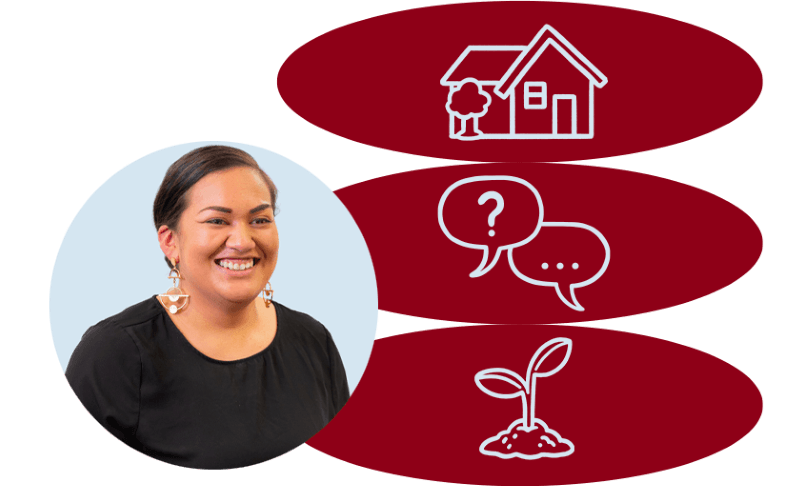Houses that support the unique living situations of different communities are vital. But that means more diverse architects are needed to design them.
She was once a young Sāmoan girl with no shoes living in a state house in Porirua, Wellington. Now she’s the only registered female architect of Sāmoan descent in Aotearoa.
During the 2020 lockdown, Ti’afelelea’i Carinnya Feaunati applied to become a registered architect. Like most application forms, it asked for her ethnicity, to which Feaunati proudly ticked the box for Sāmoan. “After submitting my papers, which included case studies, the administrator replied back with a side comment saying, oh great you’ll be our only registered Sāmoan architect if all goes well, which took me by surprise,” she says.
After a bit of fact checking, Feaunati confirmed it for herself: there were no other female Sāmoan architects registered in Aotearoa. “It’s an amazing accomplishment for me, but it was sombre at the same time because it showed what the situation is like for Pasifika people in the industry.”
According to New Zealand Institute of Architects, across New Zealand’s three architecture schools, the overall graduate numbers for Māori and Pasifika are low: 9% for Māori and 4% for Pasifika. Unitec has the highest proportion of Māori and Pasifika graduates.
Feaunati is a registered architect and cultural design adviser at Designgroup Stapleton Elliott, and teaches at Victoria University’s School of Architecture. She says she’s a firm believer in the saying “you can’t be what you can’t see”. There was no one in Feaunati’s family that had even a remote connection to the profession, but it was one she was drawn to through her upbringing, living in state housing. It made her think about the sorts of homes seen as acceptable for those with fewer financial resources. “The majority of people in state houses are Māori and Pasifika. Just because finances are not quite there, why should that decide the quality of the housing?”
Feaunati was intrigued by the problem-solving aspects of architecture. She realised that architects not only have a huge influence on the built environment all around us – they have the ability to help people live healthier, safer lives as well. “It was such a profound moment for me,” she says. “I could help families like my own live in better housing conditions simply by being in that position of influence.”
Although she had no role models in the field during those early years of goal setting to get into architecture school, that slowly changed. At Victoria University she met a few Pasifika architecture students, who all became good friends. When she did finally get into architecture school, she told herself she would hold the door open for future Pasifika students. “We’re modest people, but I had to be vocal about celebrating my achievements and my work for the sake of visibility. I do this so that other Pasifika people can see what they’re capable of doing,” she says.
A common thread in Pacific cultures is the ingrained sense of service. Young Pasifika people grow up asking how they can serve others, both in their family and their community. Feaunati chose architecture because it aligned with those values. “Architecture is very colonised,” she says. “It’s very much ‘this is my vision, this is my building and look at this amazing house I built’, but there’s a major shift in the field.” Nowadays, she says, architects are embracing different visions of what communities can be, and asking the people who actually live there what they want to see in their spaces.
As the number of Pasifika living in Aotearoa grows, inclusive architecture that’s supportive of Pacific communities and the Pacific way of living is increasingly important. But if there are no Pasifika architects involved in the design and development of these communities, that’s a problem. “That’s why it’s important to get many diverse voices in this field, so that the built environment reflects the needs of the people it serves,” Feaunati says.
Dr Karamia Muller is a lecturer at the School of Architecture and Planning at the University of Auckland, specialising in indigenous space concepts. Asked why it’s crucial that Pacific people have visibility within architecture, she says it’s simple: Pacific people have a unique set of values which are very important to them. “To see those values coded or built into architecture enables us to live more full and whole lives and when we see those values behind the buildings, the design decisions, it’s more likely we’ll have future buildings that reflect us and uphold our mana,” Muller says.
Intergenerational housing and spaces that can cope with domestic population changes – such as the multi-generational families that so often fill Pacific homes – are a priority, Muller says, quickly adding, “I’m not the first to say that though”. Another priority for Pasifika families is having a space where they can celebrate important milestones such as birthdays, where they can host multiple families of all sizes and conduct cultural customs accordingly.
An example of these sorts of special needs is a Tongan engagement custom called faitohi where the man visits his partner’s family home and asks the woman’s father for permission to marry his daughter. The prospective groom is accompanied by his extended family gifting food, tapa cloths, fine mats, beverages, baskets of fruits and cakes to the family of the bride-to-be. It’s not unusually for there to be more than 100 people in attendance. As Muller says, having architects who can design spaces to cater to such customs – and understand, feel and embody the Pacific culture in the houses they create – will make all the difference for future generations.
This is Public Interest Journalism funded through NZ On Air.



